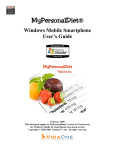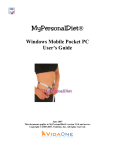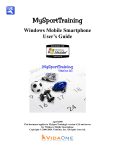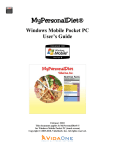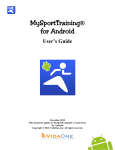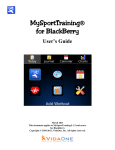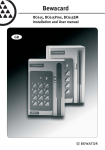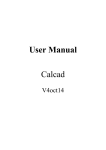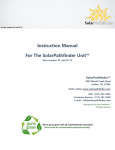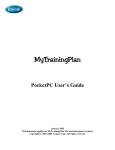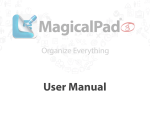Download VidaOne MyPersonalDiet User`s guide
Transcript
MyPersonalDiet® for iPhone and iPod Touch User’s Guide April 2010 This document applies to MyPersonalDiet® 1.5 and newer for iPhone and iPod Touch Copyright © 2010, VidaOne, Inc. All rights reserved. Table of Contents 1 2 3 4 5 6 7 8 Introduction ................................................................................................................. 4 1.1 What Is MyPersonalDiet®? ................................................................................ 4 1.2 How About Exercising? ...................................................................................... 5 1.3 VidaOne Diet & Fitness for Windows 7, Vista and XP ..................................... 6 1.4 Technical Support ............................................................................................... 7 Setting Your Goals ...................................................................................................... 8 2.1 Units and Profile ................................................................................................. 8 2.2 Weight Goal ........................................................................................................ 9 2.3 Duration ............................................................................................................ 10 2.4 Diet Summary ................................................................................................... 10 Today View ............................................................................................................... 11 Meals, Workouts and Health records ........................................................................ 12 4.1 Entering Meals .................................................................................................. 13 Entering Food Items .................................................................................................. 13 Food Browser ............................................................................................................ 13 Favorite Food Items .................................................................................................. 16 Searching Food Items ............................................................................................... 17 Combining Food Items Into Dishes .......................................................................... 18 Entering Your Own Food Items ................................................................................ 19 Enter Additional Servings ......................................................................................... 20 4.2 Entering Workouts ............................................................................................ 21 4.3 Entering Health Records ................................................................................... 23 Choosing a Diet......................................................................................................... 24 5.1 Diet Plan............................................................................................................ 25 5.2 Nutrients ............................................................................................................ 25 5.3 Energy ............................................................................................................... 25 5.4 Meals ................................................................................................................. 26 Monitoring Your Diet ............................................................................................... 27 6.1 Today View ....................................................................................................... 27 6.2 Journal ............................................................................................................... 27 Daily Summary ......................................................................................................... 27 Diet Summary ........................................................................................................... 28 Meals, Workouts and Health Journal ........................................................................ 28 6.3 Month view ....................................................................................................... 29 6.4 Charts View ...................................................................................................... 30 6.5 Getting Results .................................................................................................. 31 GPS Recording.......................................................................................................... 33 Laps ........................................................................................................................... 34 Listening to Your Music ........................................................................................... 34 Live Recording Tips ................................................................................................. 35 Settings ...................................................................................................................... 36 8.1 General Settings ................................................................................................ 36 8.2 Profile................................................................................................................ 36 8.3 Display .............................................................................................................. 36 8.4 Tools ................................................................................................................. 36 MyPersonalDiet for iPhone and iPod Touch User’s Guide 2 Features ..................................................................................................................... 38 9.1 Synchronization ................................................................................................ 38 9.2 Purge Data ......................................................................................................... 40 9.3 Passcode Lock ................................................................................................... 41 10 What To Do Next? .................................................................................................... 42 9 MyPersonalDiet for iPhone and iPod Touch User’s Guide 3 1 Introduction 1.1 What Is MyPersonalDiet®? Most if not all health-conscious people spend a considerable amount of time and energy tracking the food they consume, and for various reasons, such as: • • • • To maintain, lose or gain weight To consume enough of some nutrients To limit their consumption of some nutrients To follow a balanced diet MyPersonalDiet is designed to help you establish a diet and weight goals, enter the data that matters to you (food, health and workouts), track that data and monitor your condition. This is an ambitious, feature-loaded application that is focused on assisting you reaching your goals. Figure 1: MyPersonalDiet Day view presents key information about your diet, such as daily energy summary (left) and diet summary (right). MyPersonalDiet consists of four views, described later in this manual: • • • • The Day view shows relevant information for the day, and allows you to enter meals, health data, workouts, revisit your goals, set your diet and get results. The Month view shows a calendar that displays if your weight is on target or not for each day. The Report view presents various summary lists. The Charts view allows you to see various charts. MyPersonalDiet for iPhone and iPod Touch User’s Guide 4 1.2 How About Exercising? Dieting is not only about food and diet tracking, but also exercising. For this reason, VidaOne also offers MySportTraining (see Figure 2), the most comprehensive fitness software for iPhone and iPod Touch. Figure 2: MySportTraining is the premier fitness application for your iPhone and iPod Touch. MySportTraining offers a variety of features that complement MyPersonalDiet: • • • • • • You can track aerobic (cardio-vascular) and strength training workouts. You can use one of the predefined activities or create your own. You can track workout in details, and it even calculates the amount of calories you burn while exercising. It’s a must at the gym, because you can choose from pre-defined exercises (illustrated), purchase additional exercise series (also illustrated) or add your own exercises (and optionally attach pictures to them). It features a body chart that highlights the various muscle groups. You can tapand-hold any muscle group to get a list of exercises to add variety. The month view shows all your workouts at-a-glance to appreciate your accomplishments. The chart view shows a variety of motivating charts to see your improvement over time. Find more about MySportTraining by visiting http://www.VidaOne.com/imst.htm. MyPersonalDiet for iPhone and iPod Touch User’s Guide 5 1.3 VidaOne Diet & Fitness for Windows 7, Vista and XP MyPersonalDiet is fully compatible with VidaOne Diet & Fitness for Windows Vista and Windows XP. It not only provides the same features than MyPersonalDiet, but also allows you to customize the food database (such as removing items you never consume), import and export food items, add custom data fields, enter all the details about your workouts, download Polar® and Garmin® heart rate monitor information, view a variety of reports and graphs (all printable), use multiple profiles (users), and more. Figure 3: VidaOne Diet & Fitness for Windows provides the same features than MyPersonalDiet and much more, and the data is synchronized via Wi-Fi. MyPersonalDiet synchronizes with VidaOne Diet & Fitness via Wi-Fi (more in section 9.1). This allows you to use either application to enter data and make sure they always remain in sync. VidaOne Diet & Fitness makes it easier to review report (on a larger screen), and offers a backup of your data should your iPhone be lost, damaged or stolen. MyPersonalDiet for iPhone and iPod Touch User’s Guide 6 The synchronization also works when you run VidaOne Diet & Fitness in emulation on Mac OS X using Desktop Parallels® or VMware Fusion™. Figure 4: MyPersonalDiet for iPhone synchronizes with VidaOne Diet & Fitness for Windows. More information about VidaOne Diet & Fitness, including a user’s guide such as this one, is available at www.VidaOne.com/vodf_win.htm. 1.4 Technical Support You can obtain more information about our products, updates, etc. by visiting our Frequently-Asked Questions (FAQ) page at: http://www.VidaOne.com/faq.htm. If you have a question, want to provide some feedback, or want to report a problem, please send us an email at: [email protected]. You can also contact us by mail at the following address: VidaOne, Inc. 7101 W. Highway 71 Suite 220 Austin, TX 78735 MyPersonalDiet for iPhone and iPod Touch User’s Guide 7 2 Setting Your Goals The first time you open MyPersonalDiet, the Welcome Wizard introduces you to the application and gathers your preferences and profile information (see Error! Reference source not found.). 2.1 Units and Profile You can specify whether to use American or Metric units, calories or kilojoules, and choose the first day of your week (Saturday, Sunday or Monday). These choices are reflected throughout the application in the various views (Journal, Calendar and Charts). Your profile consists of your gender, birth year, weight and height, all required to perform various calculations as you enter workouts. You can change these settings at any time afterwards (see section 8). MyPersonalDiet for iPhone and iPod Touch User’s Guide 8 2.2 Weight Goal Based on your profile, MyPersonalDiet calculates your Body Mass Index (BMI) and presents you with a chart showing your weight vs. various weight ranges (see Figure 5). You can then quickly find out and enter your target weight and as a result, set a realistic weight goal. Figure 5: Based on your profile, MyPersonalDiet helps you identifying your target weight. MyPersonalDiet for iPhone and iPod Touch User’s Guide 9 2.3 Duration Once your profile and target weight are known, you have to choose how long your diet will take. MyPersonalDiet presents you a period in which you can reach your target weight following a healthy diet (see Figure 6). It is very important to choose a realistic duration (within the proposed range). Not doing so can hurt your health. Figure 6: MyPersonalDiet presents you a period by which you can reach your target weight in a healthy manner. 2.4 Diet Summary With your profile, target weight and diet duration entered, MyPersonalDiet summarizes your diet and shows you how many calories (or kilojoules) you need to lose (or gain) every day in order to reach your target weight. This gives you a solid daily guideline to establish your food and exercises habits. MyPersonalDiet for iPhone and iPod Touch User’s Guide 10 3 Today View Choose Today in the menu bar to display the Today screen (Figure 7), which displays a diet summary (also shown in the Journal), and allows you to enter a meal, workout, health record (section 4), start a GPS recording (section 7) and synchronize with VidaOne Diet & Fitness (section 9.1). See an immediate assessment of your diet. This icon is shown if you have previously synchronized with VidaOne Diet & Fitness. Figure 7: The Today screen provides a daily summary and quick access to common functions. MyPersonalDiet for iPhone and iPod Touch User’s Guide 11 4 Meals, Workouts and Health records To view the information you’ve previously entered, go to the Journal (by tapping on the Journal button in the menu bar) and tap on the Meals, Workout or Health buttons at the top of the screen. Figure 8 shows the meals and workouts Figure 8: The Meals, Workouts and Health buttons show the relevant information for a day. The figures above show the meals and workouts for a given day. The upper area allows you to select a different day: • • • Tap on the date to choose another. Tap on the Today button to see the data for today. Use left or right arrows to display the previous or next day that has some information of the same type (e.g. meals). To add a meal, workout or health record, tap on the meal, workout or health record button and then tap on the Add button . Tap on a meal, workout or health record to edit or delete it. MyPersonalDiet for iPhone and iPod Touch User’s Guide 12 4.1 Entering Meals To enter a meal, go to the Today screen and tap the Meal tap the Meal and Add buttons. button, or go to the Journal Select these tabs to enter specific food items for the meal, see nutritional information, enter additional servings, or enter a note. Dishes allow you to combine food items together. You can later enter a dish by selecting it and tapping Add to Meal. Figure 9: The Meal screen allows you to enter food items for a meal. It consist of four sections: meal items, nutrients, extra servings and a note. Depending on the time of the day, a type of meal will automatically be selected based on your meal schedule (section 5.4); you can change it if need be. Entering Food Items Tap on Add Food Item to add an item (more about this below). Tap on an item to edit it. Tap the Delete button on the left to remove a food item. You will later see how food items can be combined in dishes. Initially, the Dishes list is empty the first time you use MyPersonalDiet, but once dishes are created, you can select them next to Dishes and tap Add to Meal for their food items to be added to the list. When you tap Add Food Item from the Meal window, the Food Browser is shown (see Figure 10). This is the principal window by which you enter the food you consume. Food Browser To select a food item in the Food Browser (Figure 10), first select a food group, a category and then choose a food item. Upon choosing an item, the calories (or kilojoules), points, and the energy from carbs, protein and fat are displayed, along a pie chart. In Figure 10, because a low-carb diet is selected (see section 5.1), “High carbs!” is shown to let you know that this food is possibly not suited for your diet. MyPersonalDiet for iPhone and iPod Touch User’s Guide 13 You can enter the amount by using the keyboard or spinners. The calories and nutrients are then updated below. Tap Add To Meal to add the food item to the meal. Use these buttons to see the complete name, energy information and nutrients for the food item. See where the calories are from (carbs, proteins, fat) at a glance. You are notified if the food is not a good fit for your diet (e.g. a high carb food for a low carb diet). Tap these to add a custom food, copy the current food into a custom food, search for keywords or select from your favorite food list. Figure 10: The Food Browser window allows you to browse the entire food database and enter the amount you consumed of the selected food item. Tap the Description button to see the detailed name of the food item, and to see the amount of specific nutrients (see Figure 11) (this is useful to closely monitor specific nutrients based on your diet). You can choose which nutrients to track (see section 8.4). All this information lets you find out exactly what you consume. Go ahead, and browse the whole database to learn about what you are really eating! You’ll be surprised! Figure 11: The Food Browser’s nutrient page allows you to see your preferred nutrients and the complete nutrition facts. MyPersonalDiet for iPhone and iPod Touch User’s Guide 14 Then choose the amount (or quantity) you consumed, and the unit. The unit depends on the food item, but “serving”, “g or ml” and “oz” are always listed. The calories (or kilojoules), energy and nutrients are updated according to the amount. Once done, tap Add To Meal to add the food in the meal. A small window will pop up to confirm that the item was added (Figure 12). Food items that you add are also automatically stored in the Favorites list (more about this shortly). Figure 12: A small window is shown to confirm that the food item was added to the meal. MyPersonalDiet for iPhone and iPod Touch User’s Guide 15 Favorite Food Items Whenever you add a food item into a meal, that food item it added to the favorites list. The favorites food item list is accessible from the Food Browser’s Favorites button This shows the most recent food items you entered in a meal; tap on any to select it. Using the Favorites is a quick way for selecting food items you frequently consume. . Tap the Settings button to set the size of the list (the default is 100 items). When the limit is reached, new items are added and older items are removed from the list. Tap the arrow to set options(pin, always use 1 serving) or remove the item from the list. Figure 13:The Favorite Food Items window lists all your favorite food, grouped alphabetically. The list has a limit of items that can be added. The purpose of this limit is to discard food items you rarely consume and keep the number of items to a reasonable size. The limit is set to 100 and you can change it via the Settings button in the top right corner. You can “pin” an item to make sure the item is not automatically removed from the list as new items are added. To “pin” and “unpin” an item, tap on the arrow to show the Options screen and select Yes/No next to “Pin” When you select a food item, it is added to the meal using an amount of “1 serving”. If you prefer to be prompted for the amount every time you select the item, tap on the arrow to show the Options screen and select No next to Always use 1 serving. MyPersonalDiet for iPhone and iPod Touch User’s Guide 16 Searching Food Items You can search the food database from the Food Browser’s Search button . In the Search window (see Figure 14), enter a word (or part of a word) and tap Search to show the matching food items from the food database and from your own food. Tap on one to select it. You can add multiple words, and use the minus sign (-) to exclude keywords from the search. If you are using VidaOne Diet & Fitness, you can create a food filter to eliminate the food you never consume. That filter is synchronized with MyPersonalDiet Use this scroll bar to see the full item names. Figure 14:The Search Food window allows you to search the food database for a specific keyword. Searching by one word can return too many. To perform a more effective search, enter several words, and only items containing all words will be shown. What’s more, prefix a word with an hyphen (–) to exclude food items that contain that word. In Figure 14, the figure on the right shows the entries returned when searching for both milk and 1%, but not cheese (reducing the number of entries). MyPersonalDiet for iPhone and iPod Touch User’s Guide 17 Combining Food Items Into Dishes You can save one or more food items as a dish, and use that dish later on to expedite data entry. From the Meal screen (Figure 9), add a list of food items, then tap New under Dishes. This shows the Add Dish screen (Figure 15), and allows you to enter the dish name, its serving size, the amount of servings it contains and whether one (1) serving should automatically be added when the dish is selected or if you should be prompted for the number of servings instead. To use an existing dish, tap on the Dishes entry at the bottom of the Meal screen, select a dish, return to the Meal screen, and then tap Add to Meal. A single serving of that dish will be added, unless the option “Always use one serving when adding this dish” was selected when adding/editing that dish; in that case, you will be prompted for the exact amount to use. Figure 15:When you create a dish, you enter its name along the servings it contains. You can later recall that dish and specify the amount of servings you actually consumed. To rename a dish or change the servings it contains, select a dish from the dishes list, and tap the arrow , which will show the Edit Dish screen (similar to the Add Dish screen). To update the content of a dish with the food items currently listed, select a dish from the dishes list, and tap Update. To delete the dish, select the dish in the dishes list, tap the arrow Deleting a dish does not remove the food items currently listed. MyPersonalDiet for iPhone and iPod Touch User’s Guide and tap Delete Dish. 18 Entering Your Own Food Items You can add your own food items by tapping the Add button in the Food Browser. This shows the Custom Food screen (Figure 16). Enter the name, select a category (the Category screen lets you add your own), select the default serving size (e.g. 100 g, 1 cup, etc.), the calories (or kJ) for that serving, the nutrients and a note if desired. Note When entering the serving size, make sure to enter the weight, not the volume. For instance, a cup (volume) of cereals is approx. 2 oz (weight), so 2 oz must be entered, not 1 cup. The weight is required to properly calculate nutritional information. Food labels always show the serving size in weight (and sometimes, also the volume). Choose the Calculator button to calculate the energy based on the nutrients you’ve entered. The calculation is based on 4 calories per gram of Total Carbs and Protein, and 9 calories per gram of Total Fat. You can choose to enter the nutrients by weight (g or mg), or by percent daily value (%DV) Nutrients are listed in the same order than you find on US food labels. Figure 16: The Custom Food screen allows you to enter you own food items. You can enter your own category and all the nutrients of the food item. Form the Food Browser, you can create a custom food as a copy of the selected food item by tapping the Copy button . Food items from the database cannot be changed, but you can copy them into custom foods and adjust them as needed. MyPersonalDiet for iPhone and iPod Touch User’s Guide 19 Enter Additional Servings When entering a meal (see Figure 9), select the Servings information for the meal: button to enter extra • Amount of water servings you consumed (one serving is 1 cup or 250 ml). • Extra calories (or kilojoules) for the meal. If all you want is to track is the energetic value of a meal, you can simply enter it there, without providing additional information. Note that the nutrients will remain zero for this meal. • Additional servings for the meal (see Figure 17). This is useful when you eat a meal composed of a variety of food items: instead of entering each of them individually, you can estimate how many servings of each food group the meal is composed of, and only enter the servings. MyPersonalDiet uses average energetic values per food group serving, as displayed in following table (values are rounded for simplicity) Food group Starch (grains) Protein Fruit Vegetables Dairy Fats, oils, etc. Total cal. 90 179 98 69 102 108 Cal. from carbs 68 29 90 52 16 31 Cal. from prot. 8 56 3 8 27 4 Cal from fats 14 94 5 9 59 73 Table 1: Energetic values per food group (per serving). Figure 17: You can enter extra servings (in addition to the specific food items) when entering a meals. This is especially useful when eating a meal composed of a mix of various foods. MyPersonalDiet for iPhone and iPod Touch User’s Guide 20 4.2 Entering Workouts To enter a workout, go to the Today screen and tap the Workouts button, or go to the Journal, tap on the Workout and Add buttons. This shows the Workout screen (Figure 18). Use these buttons to enter general information, route, custom fields (when using VidaOne Diet & Fitness) and a note. You can select one of the pre-defined activities or add your own. Based on the duration and exertion, MyPersonalDiet can calculate how many calories you burnt and how much fat you lost! Figure 18: The Workout window lets you enter basic information about your workouts. You can use one of the predefined activities, or create your own. You can choose one of the predefined activities, or create your own (more on this shortly). Then enter the duration and the exertion level, and MyPersonalDiet will calculate the energy expenditure (in calories or kilojoules), along the fat being burnt out during the execution of the workout. You can also enter your average heart rate if you use a heart rate monitor. The duration and the average heart rate can be charted in the Charts view. To create your own activity, tap on the Activity entry. This shows Activities screen, which shows the most recently-used activities first. Tap the Add button to create your activity (Figure 19). Enter the activity name, the type (cardio or strength), and choose an icon and icon color. You can also specify how much energy this workout requires when done for 30 minutes at a moderate intensity. This provides MyPersonalDiet with the ability exactly calculate how much energy is burned based on the duration and exertion you enter later on. If you are using VidaOne Diet & Fitness (described in section 1.3) and have created custom fields, you can select them by tapping on the Custom Fields button. MyPersonalDiet for iPhone and iPod Touch User’s Guide 21 Figure 19: When you create your activities, you can enter a measure of the energy your burn, and MyPersonalDiet will be able to conduct accurate calculations based on the time and exertion. MyPersonalDiet for iPhone and iPod Touch User’s Guide 22 4.3 Entering Health Records To enter a meal, go to the Today screen and tap the Meal button, or go to the Journal tap the Meal and Add buttons. This shows the Health window (Figure 20). You can enter multiple health records per day. You can enter general health information, such as your weight, body fat percentage, blood pressure, mood and activity level. The weight is very important if you are on a diet for MyPersonalDiet to better monitor your progress. The weight, body fat and blood pressure can be charted in the Charts view. Use the body measurement button to track the size of your neck, biceps, forearm, wrist, chest, waist, hip, thigh, calf and ankle. Each can be charted in the Charts view. You can track various blood markers by tapping on the Blood Markers button. This shows a table with 22 blood markers, which you can track in the Charts view. You can later chart these values in the Charts view. All blood markers are always listed. Select these buttons to enter weight, vital signs, blood work markers, measurements, custom fields (available with VidaOne Diet & Fitness) and a note. Figure 20:The Health window lets you enter key information about your health, along body measurements. If you are using VidaOne Diet & Fitness (described in section 1.3) and have created custom fields, you can select them by tapping on the Custom Fields button. MyPersonalDiet for iPhone and iPod Touch User’s Guide 23 5 Choosing a Diet You can choose the diet you want to follow and identify nutrients to track and the daily energy. From the Journal, choose the Diet tab and Diet button, which shows the Diet screen, composed of the Plan, Nutrients, Energy and Meals (Figure 21), explained in the following sections. Figure 21: The Diet screen allows you to choose a diet plan and track specific nutrients and select your daily energetic requirements to calculate the %DV. MyPersonalDiet for iPhone and iPod Touch User’s Guide 24 5.1 Diet Plan The Plan page allows you to select one of the following predefined diets: • • • • • • USDA Food Pyramid High Carb Low Carb High Protein Low Protein Low Fat As you select them, the energetic percentage from the major nutrients (carbohydrates, proteins and fat) are displayed (see Figure 21, first row, left). In addition, you can choose Custom Plan and select the exact proportion of energy from these nutrients. Later on, as you enter food, you will be warned when food do not match these requirements (see section 4.1 for more details). This allows you to avoid food that may possible not be a good fit for your diet. 5.2 Nutrients You can track specific nutrients to make sure that you consume enough of them and/or do not consume too much of them. This is of prime important for those who have a medical condition that imposes some restrictions on specific nutrients. The Nutrients page shows you a list of nutrients for which you can optionally assign a daily minimum and/or maximum limits (see Figure 21, first row, right). For instance, if you need to follow a low sodium diet that does not exceed 1800 mg of sodium per day, enter 1800 under Maximum next to Sodium. If you need to consume at least 1000 mg of calcium daily, then enter 1000 under Minimum, next to Calcium. You can later chart these nutrients in the Today, Journal and Chart views to see where you stand with regards to the limits you chose. For instance, from the Journal view, you can see a chart of your daily sodium consumption and be informed whether you can consume more of it for the day (and how much) or if you’ve exceeded the limit (and by how much). This gives you the ability to precisely control your diet and make sure you are following your own guidelines. 5.3 Energy You can set a limit of the energy you want to consume daily (e.g. 2000 calories). This is used for calculating the daily dietary intake (%DV). MyPersonalDiet for iPhone and iPod Touch User’s Guide 25 5.4 Meals You can enter the time of day and the amount of energy for each meal you consume on a daily basis. Based on that schedule, MyPersonalDiet can determine the meal type of each meal as you enter it, and you can later see using the Meal Schedule chart (section 6.4) whether you follow this schedule or not, and how much energy you consume on average per meal. This is very useful in two situations: 1) If you are on a weight loss diet, two common problems are eating between meals, and consuming too much food at night. The Meal Schedule chart will immediately let you find out if you are eating outside your planned meal schedule and too much at certain meals. 2) If you are an athlete or someone with food restrictions, and you consume several meals a day (4 or more), the meal schedule and the Meal Schedule chart will greatly help you making sure that you are eating enough at each meal (as opposed to eating too much in some meals and not enough in others). MyPersonalDiet for iPhone and iPod Touch User’s Guide 26 6 Monitoring Your Diet MyPersonalDiet provides different methods for monitoring your diet from different perspectives. 6.1 Today View The Today view (section 3) displays the same daily summary (section 6.2) as shown in the Journal . This is a very quick way of tracking daily calories or a specific nutrient. 6.2 Journal The Journal gives you immediate information about your daily energetic and nutritional consumption, diet progress, meals, workouts and health information Figure 22: The Day view gives you an instant snapshot of your day (left) and diet (right). Daily Summary The daily summary presents daily information about energy from meals vs. workouts and BMR. The value shown for the BMR is either adjusted for the time of day or the whole day, depending on the BMR adjustment option (see section 8.4 for more details). You can also track any nutrient by tapping on Calories (or Kilojoules) and selecting a nutrient from the list being shown (you can customize the nutrients being shown, as explained in section 8.4). Figure 23 shows a daily summary of carbs consumption with a 250 g maximum limit, a daily recommend value (DV) of 300 g. With this information, you can immediately find out how much energy or how much of a given nutrient you’ve consumed for the day, and how much you’re allowed to consume for the remaining of the day. MyPersonalDiet for iPhone and iPod Touch User’s Guide 27 Figure 23: You can monitor your energetic summary or any nutrient, such as carbohydrates. Diet Summary The diet summary immediately lets you know if you are on track with your diet goal or not. The chart covers the diet period. The vertical blue bar shows the current day and the gray bar shows the target weight (from your initial weight to your target weight). Your actual weight, as entered via health records, is shown in red, whereas the weight trend is shown in blue. The weight trend is what matters the most because it discards the normal daily weight fluctuations, and shows you where you weight is heading to. For instance, in Figure 23, although the red line has various ups and downs, the trend line clearly shows that the weight is going down, even if it went up once as some point. Following the red line is misleading because its fluctuations don’t give a long-term perspective of the diet. In Figure 23, there are various ups, which are not relevant as the trend shows that the weight is clearly heading down. Meals, Workouts and Health Journal The day view also includes three tabs that contain daily information about your meals, workouts and health. Section 4 explains how to enter that information. MyPersonalDiet for iPhone and iPod Touch User’s Guide 28 6.3 Month view The Month view shows a snapshot of your diet for a whole month (see Figure 24). Each day is shown as follows: • • • • If you entered a weight for that day, it is shown in black. Otherwise, the target weight (as calculated based on your diet goal) is shown in blue. The weight is shown in gray for days outside the current month. If the weight in within 5% of the target weight, a Congratulations smiley is shown. This means that you are on track with the target weight. If the weight in within 10% of the target weight, a Happy smiley is shown on a yellow background. This means that your weight is not where it should be, but that’s usually not a problem, because fluctuations are normal and expected. If the weight is not within 10% of the target weight, then a Watch out! smiley is shown on a red background. This signals that your weight is not in line with the goals. Occasional “red days” (as shown in Figure 24) are normal, because they show weight fluctuations. However, if the calendar is mostly filled up with yellow or red days, then your weight is no longer on track with your goals. Weekly weight gain/loss are shown in the green column on the right. Figure 24: The Month view shows your weight and whether it is on track or not with your goals. In this snapshot, the diet is being very well followed up. Each day is also shown with small icons representing meals, workouts and health if such information was entered on that day. Tap on a day to access the Journal view for that day. A weekly summary is also shown on the right side, which highlights the weight difference between the last day of the weeks. MyPersonalDiet for iPhone and iPod Touch User’s Guide 29 6.4 Charts View The Charts view presents various charts to get a quick snapshot of various aspects of your diet. Figure 25: The Charts view lets you visualize all elements of your diet. You can choose what to display from the list on the top left corner. The list contains the following: • • • • • • • • • • • • • • • Calories Calories (Net) Calories per Hour Meal Schedule Points (if enabled, see section 8.4) Body Weight Body Fat Body Measurement Carbs-Prot-Fat %, the percentage of calories from carbs, proteins and fat. This is particularly useful to compare with your diet plan (see section 5.1). Nutrients. You can choose which nutrients to be listed via the Nutrients options (see section 8.4 for more details). Nutrients are shown along limits if some were entered (see section 5.2 for details). Blood Pressure Health markers. You can choose what health markers to be included via the Health options (see section 8.4 for more details). Workout duration Workout distance Workout average heart rate MyPersonalDiet for iPhone and iPod Touch User’s Guide 30 You can chose the period of the chart being shown by tapping the Period entry. You can choose one of the predefined periods (e.g. “Today”, “This week”, “Last week”, etc.) or choose your own period by choosing “Other”. You will then be prompted to enter the start and end dates. Some charts can display a dotted horizontal line that represents the average. The average is based on all the values used for calculating the charts and not on the bars/lines/dots being displayed (which only use values for a specific date range). 6.5 Getting Results You can get immediate results of your efforts by choosing the Results button in the Journal view. This shows the Results window (see Figure 26), which is composed of four areas: 1. As of Today shows where your weight is vs. your goal. You will immediately know if your weight is where it should be or not. 2. About Eating shows how many calories (or kilojoules) you need to lose (or gain) to reach you goal, and how much on average you lost (or gained) since the start of your diet. 3. About Exercising calculates how often you exercise and for how long, and lets you know if that’s enough or not. 4. What To Do shows recommendations to reach your goals, based on your actual weight and your eating and exercising habits, such as “consider eating less, or “consider eating more”, etc. Note These recommendations are only that: recommendations. Use your own judgment to determine if they are suitable for your condition or not. You may also want to seek the help of a health professional to help your reach your goals. MyPersonalDiet for iPhone and iPod Touch User’s Guide 31 Figure 26: The Results window shows if your actual weight, eating habits and exercises habits are ok based on your goals, and makes some recommendations accordingly. MyPersonalDiet for iPhone and iPod Touch User’s Guide 32 7 GPS Recording One of the most exciting features of MyPersonalDiet is the GPS recording of your outdoor workouts. It automatically records the duration and distance of a workout, and you can review these values, your pace, even the course completed so far on a map, at any time during the workout. Note: Results are far more accurate on a 3Gs than older models due to the device’s significantly-enhanced location tracking capabilities. To start a GPS recording, tap Today and then tap the GPS button to show the GPS Recording screen. You might be prompted with the message “iMPD” Would Like to Use Your Current Location”. This is shown whenever an application requires location data. Simply tap OK to continue. You will then see the message “Awaiting GPS Signal” (see Figure 27). This message is displayed until your iPhone can precisely pinpoint your current location. Under a clear sky, this may only take a second or two, but may take longer under different conditions (cloudy sky, in a forest, surrounded by tall buildings, etc.) You can tap Continue if you prefer not to wait, but the position and calculated distance may be inaccurate initially. Figure 27: When recording a workout, it may take a few moments for your current location to be accurately determined. Then the recording screen is displayed (see Figure 28). By default, the live recording begins as soon as you start moving, and pauses when you stop. That means you can put your iPhone back in your pocket or backpack and go. If you prefer tap the lock button to lock the screen; tap on it again to unlock the screen. You can disable this “Auto-stop” feature via the GPS Recording’s settings, by tapping the Settings button. The Settings screen also allows you to change lap type, the distance and speed units, GPS coordinates formats and enable the device to beep when the GPS signal is lost. During the recording, you can enter laps (see next section) by tapping the Lap button or view your current location on a map by tapping the Map button. MyPersonalDiet for iPhone and iPod Touch User’s Guide 33 You can listen to your favorite music while working out. Tap here to configure how laps how recorded, what units to display, and set some options. Figure 28: The GPS Recording screen lets you record live your outdoor workouts. Tap the Map button to see your actual route on Google Maps. When you’re done working out, tap Stop and Save Workout. You can then enter more information about the workout (see section 4.2 for details) and also review the full route on Google Maps. The only information needed at this time to save the workout is the activity, so make sure to select one first. Laps You can enter laps while working out, and the laps will be shown on the workout map. The laps can be recorded in different ways. Choose the exact method via Settings • Manual: while recording, tap the Lap button to mark a lap. • Position: in the Settings, tap Set Lap Position to mark the lap position. Every time you come near that position, another lap is automatically added. • Distance: in the Settings, enter the Distance mark, which is the distance interval between laps. Whenever that distance is completed, another lap is automatically added. Listening to Your Music You can listen to your favorite music while recording your workout. Tap the Songs button to select the songs to listen to and start playing them. Tap the Play button to choose which song to play, turn shuffle on/off, etc. MyPersonalDiet for iPhone and iPod Touch User’s Guide 34 Live Recording Tips The GPS recording will stop if you exit the application, lock the screen, turn your device off, or if the battery level falls below 20% or so. The following tips will ensure that your record is fully recorded: • • • Reduce the brightness of your screen Turn Wi-Fi off Make sure your iPhone is fully charged before working out. MyPersonalDiet for iPhone and iPod Touch User’s Guide 35 8 Settings MyPersonalDiet has various settings to personalize how the data is presented, accessible via More in the navigation bar. 8.1 General Settings The General Settings button allows you to change the following settings: • • • Units, either American or Metric Energy units, either calories or kilojoules. Usual daily activity level, excluding workouts: o Light (mostly seated) o Moderate (mostly standing) o Active (mostly walking) o Intense (manual labor). This is used to adjust your Basal Metabolic Rate (BMR). 8.2 Profile The Profile button allows you to edit the following information: • • • • Gender Birth year Weight Height 8.3 Display The Display button lets you customer the following: • • Select the first day of the week among Saturday, Sunday (default) and Monday. Select Adjust BMR to display how much energy you burnt (which is your BMR) at this moment, as opposed to the full day. For instance, if your BMR is 2000 for the whole day and this option is selected, the BMR being shown at noon (halfday) would be 1000. This option lets you find out how much food you can consume now given the time of the day. 8.4 Tools The tools buttons allow you to select the following: • Most nutrients can be displayed along the recommend percent daily value (%DV). These values are commonly found on U.S. food labels. Select the option Show % Daily Values to show these values throughout the application whenever MyPersonalDiet for iPhone and iPod Touch User’s Guide 36 applicable. Note that some nutrients do not have percent daily values (monounsaturated fat, polyunsaturated fat and sugars). • Various Health options: o Enter values to adjust the calculation of the BMR and workout energy expenditure (see section 9 for details). The values are expressed in percentage and range from -100 to 100 (0 is the default). o Choose Track points for points to be displayed along food items and meals. You can also enter your daily points target, which you can track in the Day view. o Select Body Mass Index to display a small icon next to your weight in the Health screen. That icon is based on your Body Mass Index, which is calculated based on your height and weight: Underweight Normal Overweight Obese o Select BP Warnings to display a warning/information message when you enter your blood pressure, as follows (the systolic value is the higher number and the diastolic value is the lower number): Severe High Elevated Normal Low Systolic >= 160 or Diastolic >= 100 Systolic >= 140 or Diastolic >= 90 Systolic >= 120 or Diastolic >= 80 90 <= Systolic < 120 AND 60 <= Diastolic < 80 Systolic < 90 or Diastolic < 60 • Tap Preferred Nutrients to select the nutrients of interest to you. Only those selected will be displayed in the Food Browser window as well as the nutrient lists in the Journal and Charts views, considerably reducing the size of those lists. • Tap Preferred Markers to select the blood markers of interest to you. Only those selected will be displayed in the Charts view’s health entry list, considerably reducing the size of that list. Custom markers created with VidaOne Diet & Fitness are not listed in this screen, and are always displayed when entering health records. MyPersonalDiet for iPhone and iPod Touch User’s Guide 37 9 Features 9.1 Synchronization MyPersonalDiet fully synchronizes with VidaOne Diet & Fitness for Windows (www.vidaone.com/vodf_win.htm) via Wi-Fi, allowing you to use your PC and iPhone to track your health and fitness, and make (precious!) backup of the MyPersonalDiet data. The synchronization also works when using VidaOne Diet & Fitness under Parallels Desktop® and VMware Fusion™ on Mac OS X. PDF documents that explain how to setup each emulator are available at the web address above. To synchronize, open VidaOne Diet & Fitness and click Profile > iPhone in. This opens the iPhone and iPod Touch Synchronization window (Figure 29), which shows your computer address and port, in this figure, 192.168.0.193 and 25007 respectively. Several addresses might be listed. You might have to try them all to find out which works. Keep this option selected as it significantly speeds up subsequent synchronization operations. To force a synchronization from scratch, unselect it. Figure 29: The iPhone and iPod Touch Synchronization window. In MyPersonalDiet choose More in the navigation bar and tap on the Data button and select Synchronize. The Synchronization screen is shown (see Figure 30). Enter the computer address and port values as is (as shown in Figure 29) and tap Synchronize. Select Yes next to Sync on startup to synchronize every time you open MyPersonalDiet. The iPhone prevent data for 3rd-party application to be automatically synchronized, so this option helps to make this process automatic. VidaOne Diet & Fitness maintains partnerships i.e. synchronization information with each iPhone. This allows synchronization to be very fast. If you experience synchronization issue, unselect Use Existing partnership in VidaOne Diet & Fitness to force a clean synchronization from scratch. MyPersonalDiet for iPhone and iPod Touch User’s Guide 38 Make sure Wi-Fi is ON. Enter the computer address with the dots (.) Figure 30: The Synchronization screen with a computer address and port. If the synchronization does not happen, make sure that Wi-Fi is turned ON on your iPhone, and that the address and port are entered correctly. On your PC, you might also have to modify your firewall settings to let VidaOne Diet & Fitness receive the incoming connections. Synchronization through a Virtual Private Network (VPN) may not work because of the corporate firewall in place. MyPersonalDiet for iPhone and iPod Touch User’s Guide 39 9.2 Purge Data To reduce and save storage space, you can delete past workout and health data that you no longer need. Purging data erases information that cannot be recovered from MyPersonalDiet. The data that is erased is workout and health information. Custom names such as activity names, exercises, intervals, etc. are not erased. If you are using VidaOne Diet & Fitness for Windows, records that are purged will also be deleted from your PC after synchronizing. To purge data, choose More in the navigation bar, tap on the Data button and select Purge Data. Choose how many months of data you want to keep. For instance, Figure 31 shows that the past 6 months of data will be saved, and all data older than 6 months will be erased. Then tap the Purge Data button. Figure 31: The Purge Data screen. MyPersonalDiet for iPhone and iPod Touch User’s Guide 40 9.3 Passcode Lock To make sure no one but you accesses MyPersonalDiet, you can set a Passcode, which you will have to enter every time you open MyPersonalDiet (Figure 32). To set or reset the Passcode, choose More in the navigation bar, tap on the Data button and select Passcode Lock. Figure 32: The Passcode screen allows you to keep your data for yourself. MyPersonalDiet for iPhone and iPod Touch User’s Guide 41 10 What To Do Next? How to use MyPersonalDiet depends on your motivation behind tracking your food intake. Here are a few suggestions: • Browse the food database. You will be amazed to find out what nutrients are in the food you consume. • Save common food items into dishes, which you can select later on to speed up entry. • If your weight is not an issue but you want to make sure you follow a balanced diet, choose a diet plan and enter any nutrient limit if any, and keep entering food. You will be able to identify food that may not be not in line with your diet plan, and track any nutrient that matters to you. • If the current food database does not suit your diet at all (if you live outside the U.S., or if you can’t find the food items you consume), then you can create your own food items. That will require some time at first, but after a few days, entering meals will be very fast. As mentioned above, grouping food items into dishes makes it easier. • After a few days, most of the food you regularly consume will easily be accessible from the Favorites list, so make sure to use to it for faster data entry. There are some customization features that can make MyPersonalDiet very well adapted to your exact needs: • If you have a way to calculate your Basal Metabolic Rate (BMR), and MyPersonalDiet-calculated BMR is too high or too low, you can instruct MyPersonalDiet to adjust its calculation via the Health options (section 8.4) by entering a percentage value next to BMR (%).This value will be used whenever MyPersonalDiet calculates your BMR. For instance, if you enter -10 %, MyPersonalDiet will reduce by 10 % the calculated BMR value. Changing this value takes effect immediately and is reflected throughout the application. • If the workout energy expenditure as calculated by MyPersonalDiet does not match what you think it should be (especially if you use some instruments of your own), you can instruct MyPersonalDiet to adjusts the calculation of those values via the Health options (section 8.4) by entering a percentage value next to Workout (%). This value will be used by MyPersonalDiet when the workout energy expenditure is calculated. For instance, if you enter 15%, MyPersonalDiet will increase the calculated MyPersonalDiet for iPhone and iPod Touch User’s Guide 42 energy value by 15% when you enter a workout. Changing this value is reflected when adding new or editing existing workouts. Whatever your goals are, MyPersonalDiet is designed to work for you, not the other way around. Remember that the first days of use will demand a little more because you need to find your food from the large food database. But as the favorite food and meal lists grow, entering a meal will be done in seconds after a few days. Thank you for using MyPersonalDiet! The MyPersonalDiet team MyPersonalDiet for iPhone and iPod Touch User’s Guide 43











































